May 6, 2025 | Age & Dementia Friendly, Healthy Aging
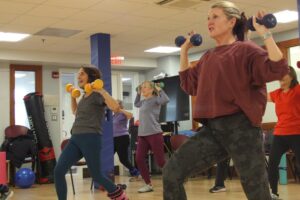
Osteofitness class participants at the Lexington Council on Aging
As we age, staying physically active is one of the best ways to maintain overall health, independence, and quality of life. Regular physical activity helps older adults stay strong, mobile, and mentally sharp. While aging naturally brings changes to the body, exercise can slow down many of these effects, making it an essential part of a healthy lifestyle. Whether it’s walking, swimming, yoga, or strength training, staying active provides numerous benefits that enhance both physical and mental well-being.
Improves Heart Health
One of the greatest benefits of regular physical activity is its positive impact on heart health. Exercise strengthens the heart, improves circulation, and helps regulate blood pressure. It also lowers the risk of heart disease, stroke, and high cholesterol. Activities like brisk walking, cycling, or swimming can help older adults keep their cardiovascular system strong and efficient.
Maintains Strength and Mobility
Muscle mass and bone density naturally decrease with age, leading to weakness and an increased risk of falls. However, regular strength training and weight-bearing exercises help maintain muscle strength and bone health. Activities like resistance training, bodyweight exercises, and even gardening can improve mobility, balance, and coordination, reducing the likelihood of injuries.
Aids in Weight Management
Metabolism slows as we age, making weight management more challenging. Regular exercise helps burn calories, maintain a healthy weight, and prevent obesity-related conditions like diabetes and hypertension. Even moderate physical activity, such as daily walks or light aerobic exercises, can make a significant difference in maintaining a healthy body composition.
Boosts Mental and Cognitive Health
Physical activity isn’t just good for the body, it’s also essential for brain health. Exercise reduces stress, anxiety, and depression by releasing endorphins, which promote feelings of well-being. Staying active improves cognitive function and memory, helping to lower the risk of dementia. Simple activities like dancing, tai chi, or even playing sports keeps the brain sharp and engaged.
Enhances Flexibility and Balance
Falls are a major concern for older adults, often leading to injuries and hospitalizations. Activities that focus on flexibility, balance, and coordination, such as yoga, Pilates, and tai chi, can help reduce the risk of falls. These exercises improve posture, strengthen core muscles, and enhance body awareness, making daily movements safer and more controlled.
Encourages Social Interaction
Exercise provides an excellent opportunity for older adults to socialize, which is crucial for mental and emotional well-being. Joining a fitness class, walking with friends, or participating in community sports fosters social connections and helps combat feelings of loneliness and isolation. Staying socially engaged has been linked to a longer, healthier life.
Promotes Better Sleep
Regular physical activity contributes to better sleep quality by regulating the body’s natural sleep-wake cycle. Exercise helps reduce stress and anxiety, making it easier to fall and stay asleep. Engaging in light activities like stretching or an evening walk can promote relaxation and lead to deeper, more restful sleep.
Staying physically active is one of the best ways for older adults to maintain their independence, health, and happiness. Exercise helps prevent chronic diseases, strengthens the body, and supports mental well-being. No matter the activity, staying active contributes to a longer, healthier, and more fulfilling life.
Apr 2, 2025 | Falls Prevention, Fitness, Healthy Aging
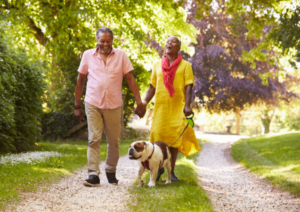 As we age, staying active becomes more important than ever for maintaining overall health and well-being. While high-intensity workouts may not always be feasible, walking is a simple, low-impact, and highly effective form of exercise that offers numerous benefits for older adults. Whether it’s a short stroll around the neighborhood or a brisk walk in the park, incorporating regular walking into a daily routine can have a profound impact on physical, mental, and emotional health.
As we age, staying active becomes more important than ever for maintaining overall health and well-being. While high-intensity workouts may not always be feasible, walking is a simple, low-impact, and highly effective form of exercise that offers numerous benefits for older adults. Whether it’s a short stroll around the neighborhood or a brisk walk in the park, incorporating regular walking into a daily routine can have a profound impact on physical, mental, and emotional health.
1. Improves Cardiovascular Health
Walking is an excellent way to keep the heart healthy. It helps to improve circulation, lower blood pressure, and reduce the risk of heart disease and stroke. Regular walking can help manage cholesterol levels and enhance heart function, making it a great activity for older adults who want to maintain cardiovascular health.
2. Supports Joint and Bone Health
One of the biggest concerns for older adults is maintaining strong bones and preventing conditions like osteoporosis and arthritis. Walking is a weight-bearing exercise that helps strengthen bones and improves joint flexibility. Unlike high-impact activities, walking puts minimal stress on the joints, making it an ideal exercise for those with arthritis or mobility concerns.
3. Aids in Weight Management
As metabolism slows with age, managing weight can become more challenging. Walking burns calories and helps prevent weight gain. A moderate-paced walk for just 30 minutes a day can help maintain a healthy weight, reducing the risk of obesity-related conditions such as diabetes and hypertension.
4. Boosts Mental Health and Cognitive Function
Physical activity is closely linked to brain health, and walking is no exception. Regular walks help reduce stress, anxiety, and depression by releasing endorphins, the body’s natural mood-boosting hormones. Additionally, studies have shown that walking can enhance cognitive function and reduce the risk of dementia by improving blood flow to the brain and stimulating mental alertness.
5. Enhances Balance and Reduces Fall Risk
Falls are a significant concern for older adults, often leading to serious injuries and hospitalizations. Walking helps improve balance, coordination, and muscle strength, which are all critical for preventing falls. By strengthening the muscles in the legs and core, older adults can improve their stability and confidence while walking or moving around.
6. Promotes Social Interaction
Walking can also provide social benefits, especially when done in a group or with friends and family. Many communities offer walking groups for older adults, fostering a sense of companionship and motivation. Social activities like walking can help combat loneliness and improve overall emotional well-being.
7. Encourages Better Sleep
Regular physical activity, such as walking, has been linked to improved sleep quality. It helps regulate the body’s internal clock, reduce stress, and promote relaxation, making it easier to fall and stay asleep. A daily walk, especially in the morning or afternoon, can lead to a more restful night’s sleep.
Walking is one of the most accessible and effective ways for older adults to maintain their health and independence. Whether it’s for heart health, mental well-being, or simply enjoying the fresh air, walking offers countless benefits with minimal risk. By making walking a part of their daily routine, older adults can enjoy a healthier, more active, and fulfilling lifestyle.
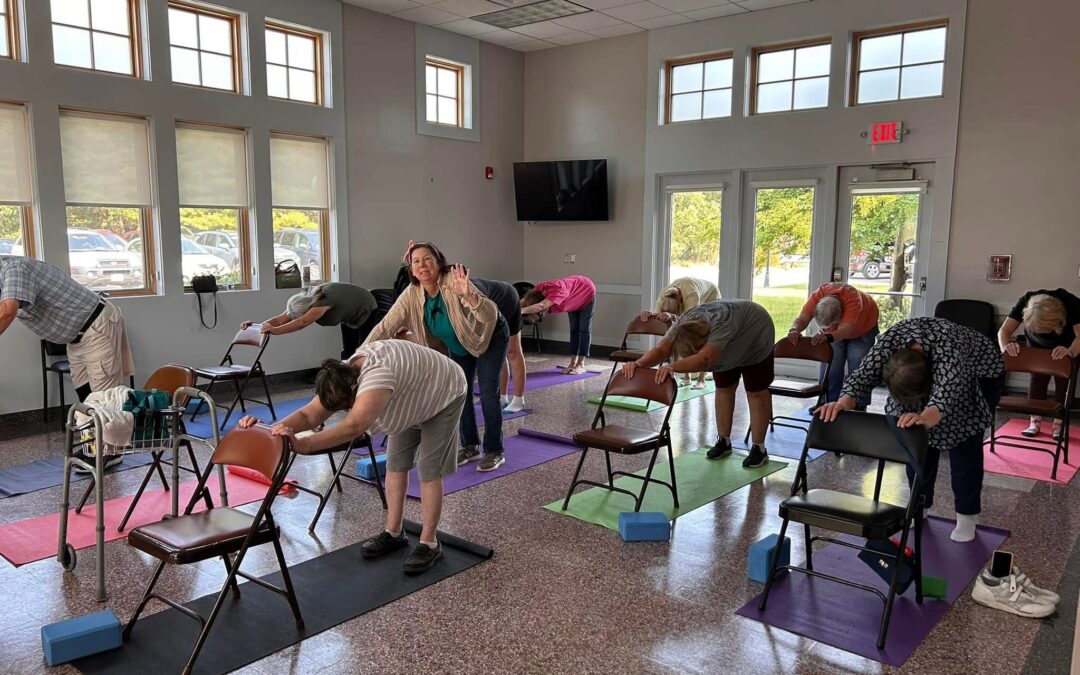
Feb 19, 2025 | Aging Matters Newsletter, Healthy Aging
At the Bellingham Council on Aging (COA), warmth and laughter are as much a part of the atmosphere as the aroma of freshly brewed coffee. Josie Dutil, the COA’s energetic director, is passionate about healthy aging and has fostered a vibrant community hub. While Bellingham COA has a long history of offering traditional yoga classes, Josie recognized an opportunity to expand their offerings and make the practice more accessible to a wider range of patrons.
“We’ve always had yoga here,” Josie explains. “But after attending a chair yoga session at the MCOA Fall Conference in 2023, it clicked. We realized we could reach so many more people by offering a gentler, more adaptable form of yoga.”
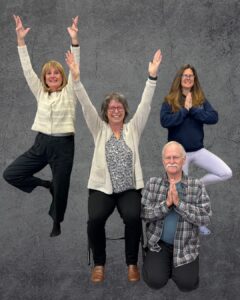 Inspired by the conference and recognizing the potential benefits for her community, Josie and her staff took action. They utilized State Formula grant funding to certify three staff members to become chair yoga instructors. This strategic investment in their team’s expertise has transformed the COA’s yoga program.
Inspired by the conference and recognizing the potential benefits for her community, Josie and her staff took action. They utilized State Formula grant funding to certify three staff members to become chair yoga instructors. This strategic investment in their team’s expertise has transformed the COA’s yoga program.
“Chair yoga is a fantastic way to introduce people to the benefits of yoga, regardless of their age or physical abilities,” Josie emphasizes. “It’s adaptable for everyone, whether they’re new to yoga or have physical limitations that make traditional mat classes challenging.”
The addition of chair yoga has significantly broadened the COA’s reach. Participants who previously felt excluded from traditional yoga classes now find themselves welcomed and empowered. The gentle movements and modifications offered in chair yoga make it possible for individuals with mobility issues, chronic pain, or other health concerns to participate fully and experience the many benefits of the practice.
“We have people in our chair yoga classes who never thought they could do yoga,” Josie shares. “They’re discovering newfound strength, flexibility, and balance, and it’s been incredible to witness their progress.”
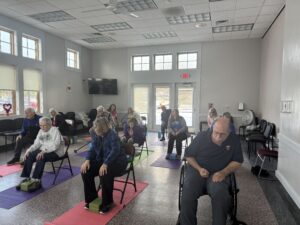 One particularly inspiring example is a family who regularly attends the chair yoga class together. The mother, a dedicated caregiver for both her husband, who uses a wheelchair after a stroke, and her adult daughter with special needs, finds a precious hour of respite and self-care in the class. “It’s clear that this time is a gift for her,” Josie observes, “a chance to focus on her own well-being amidst the demands of caregiving.” Her husband also benefits greatly, finding a supportive environment where he can move his body and connect with others. Recently, he even surprised everyone by standing during the balance portions of the class – a testament to his newfound confidence and strength. “It was a beautiful moment,” Josie recalls. “It shows how yoga can empower people to push their boundaries and discover new possibilities.” The daughter’s presence adds another layer of joy and inspiration to the class. “Her ability to live in the present moment is a reminder to us all,” Josie reflects. “This family’s participation enriches the class in so many ways.”
One particularly inspiring example is a family who regularly attends the chair yoga class together. The mother, a dedicated caregiver for both her husband, who uses a wheelchair after a stroke, and her adult daughter with special needs, finds a precious hour of respite and self-care in the class. “It’s clear that this time is a gift for her,” Josie observes, “a chance to focus on her own well-being amidst the demands of caregiving.” Her husband also benefits greatly, finding a supportive environment where he can move his body and connect with others. Recently, he even surprised everyone by standing during the balance portions of the class – a testament to his newfound confidence and strength. “It was a beautiful moment,” Josie recalls. “It shows how yoga can empower people to push their boundaries and discover new possibilities.” The daughter’s presence adds another layer of joy and inspiration to the class. “Her ability to live in the present moment is a reminder to us all,” Josie reflects. “This family’s participation enriches the class in so many ways.”
Beyond the physical benefits, the expanded yoga program has also fostered a stronger sense of community within the COA. Participants connect with one another, share experiences, and build supportive relationships. The classes provide a welcoming space for social interaction and create a sense of belonging.
The Senior Center also offers something called “Adaptive Yoga. “We make the yoga poses available to all,” says instructor Dave Dunbar. So each pose can be adapted to the needs and abilities of the people in class. “Most of the poses we do every week are done on the floor,” Dave continues, “and that means people don’t have to stand up, lie down, stand up, etc. which is hard for some.”
 “Our yoga classes are more than just exercise; they’re a community,” Josie reflects. “People look forward to coming, not just for the physical benefits but also for the social connection and the sense of camaraderie.”
“Our yoga classes are more than just exercise; they’re a community,” Josie reflects. “People look forward to coming, not just for the physical benefits but also for the social connection and the sense of camaraderie.”
The success of Bellingham COA’s expanded yoga program is a testament to Josie’s vision, her staff’s dedication, and the power of partnership with MCOA. By recognizing a need and taking proactive steps to address it, they’ve created a program that truly embodies the principles of healthy aging and community well-being. They’ve not just added a class; they’ve opened doors to a more inclusive and vibrant community.

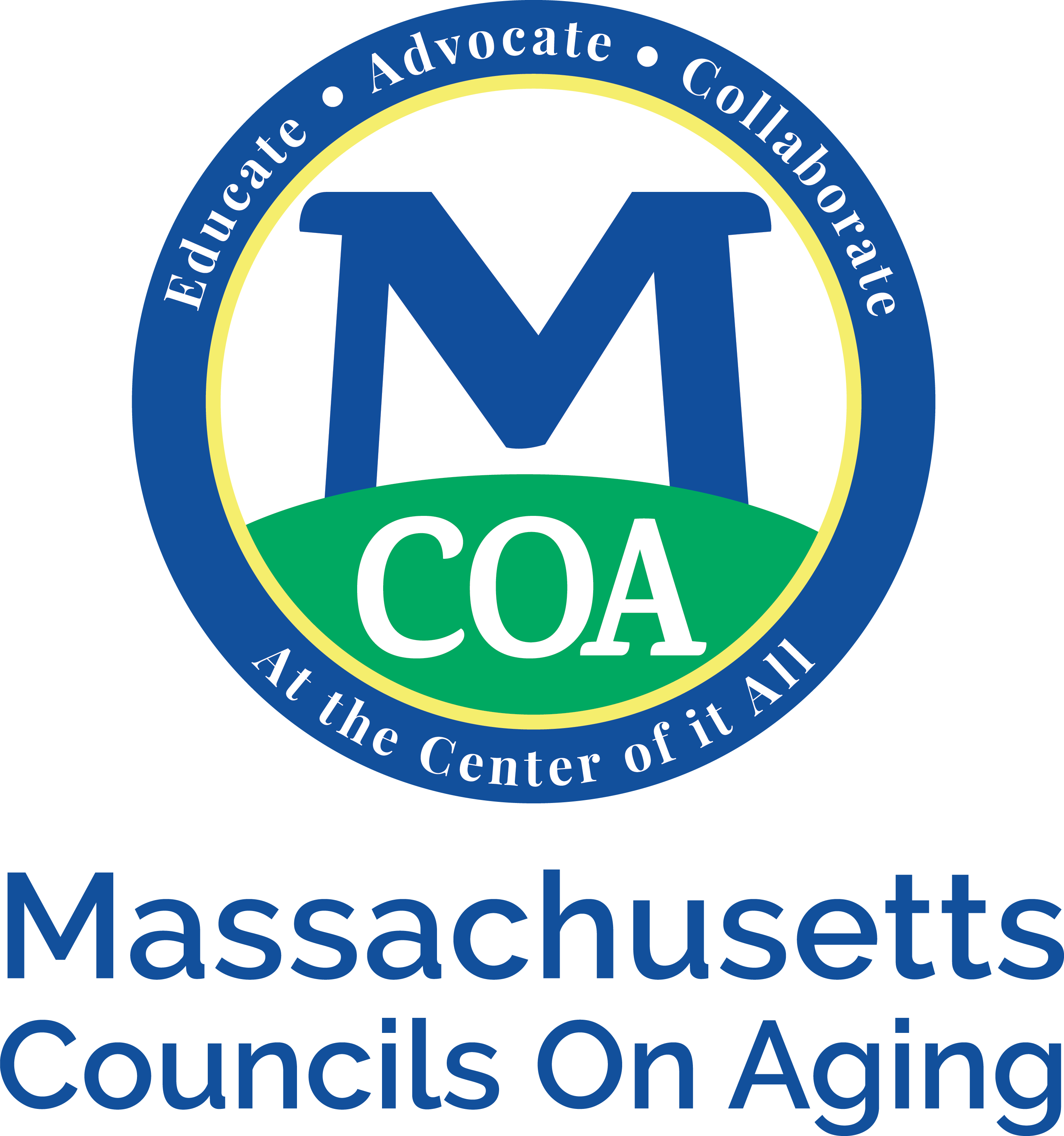
 As we age, staying active becomes more important than ever for maintaining overall health and well-being. While high-intensity workouts may not always be feasible, walking is a simple, low-impact, and highly effective form of exercise that offers numerous benefits for older adults. Whether it’s a short stroll around the neighborhood or a brisk walk in the park, incorporating regular walking into a daily routine can have a profound impact on physical, mental, and emotional health.
As we age, staying active becomes more important than ever for maintaining overall health and well-being. While high-intensity workouts may not always be feasible, walking is a simple, low-impact, and highly effective form of exercise that offers numerous benefits for older adults. Whether it’s a short stroll around the neighborhood or a brisk walk in the park, incorporating regular walking into a daily routine can have a profound impact on physical, mental, and emotional health.




